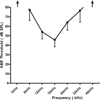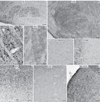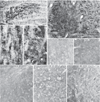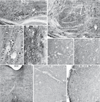Expression patterns of estrogen receptors in the central auditory system change in prepubertal and aged mice
- PMID: 20736049
- PMCID: PMC3133947
- DOI: 10.1016/j.neuroscience.2010.08.010
Expression patterns of estrogen receptors in the central auditory system change in prepubertal and aged mice
Abstract
Estrogens are important in the development, maintenance and physiology of the CNS. Several studies have shown their effects on the processing of hearing in both males and females, and these effects, in part, are thought to result from regulation of the transcription of genes via their classical estrogen receptor (ER) pathway. In order to understand the spatiotemporal changes that occur with age, we have studied the expression of ERs in the central auditory pathway in prepubertal and aged CBA mice with immunohistochemistry. In prepubertal mice a clear dichotomy was noted between the expression of ERα and ERβ. ERβ-positive neurons were found in the metencephalon whereas the majority of ERα was found in mesencephalon, diencephalon or the telencephalon. In the aged animals a different pattern of ER expression was found in terms of location and overall intensity. These age-induced changes in the expression pattern were generally not uniform, suggesting that region-specific mechanisms regulate the ERs' age-related expression. Neither the prepubertal nor the aged animals showed sex differences in any auditory structure. Our results demonstrate different age-dependent spatial and temporal changes in the pattern of expression of ERα and ERβ, suggesting that each ER type may be involved in distinct roles across the central auditory pathway in different periods of maturation.
Copyright © 2010 IBRO. Published by Elsevier Ltd. All rights reserved.
Figures










References
-
- Bakker J, De Mees C, Douhard Q, Balthazart J, Gabant P, Szpirer J, Szpirer C. Alpha-fetoprotein protects the developing female mouse brain from masculinization and defeminization by estrogens. Nat Neurosci. 2006;9:220–226. - PubMed
-
- Caruso S, Maiolino L, Agnello C, Garozzo A, Di Mari L, Serra A. Effects of patch or gel estrogen therapies on auditory brainstem response in surgically postmenopausal women: a prospective, randomized study. Fertil Steril. 2003a;79:556–561. - PubMed
-
- Caruso S, Maiolino L, Rugolo S, Intelisano G, Farina M, Cocuzza S, Serra A. Auditory brainstem response in premenopausal women taking oral contraceptives. Hum Reprod. 2003b;18:85–89. - PubMed
-
- Charitidi K, Canlon B. Estrogen receptors in the central auditory system of male and female mice. Neuroscience. 2009;165:923–933. - PubMed
Publication types
MeSH terms
Substances
Grants and funding
LinkOut - more resources
Full Text Sources
Medical

